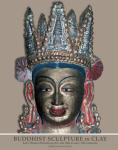 Buddhist Sculpture in Clay
Buddhist Sculpture in Clay

Large-scale clay sculptures representing the main deities are characteristics of the earliest Tibetan Buddhist monuments and particularly of the monasteries and village-temples built -from the end of the 10th to the early 13th centuries in West Tibet and Ladakh. Commonly placed in the main niches along the central axis of the monuments, these images of highest quality constitute a major source for the cultural and religious history of western Himalayan (Indo-Tibetan) art and early Tibetan art in general. Based on extensive field research and in situ documentation for more than a decade, this groundbreaking study provides a comprehensive assessment of the early western Himalayan sculptures and their context.
Western Himalayan clay sculpture is the only preserved sculptures known so far that are built in accordance with the sophisticated sculptural technique described in Indian classical literature. It is closely linked to late Northwest-Indian (Buddhist) art in which otherwise little evidence remains. By surveying the astonishing variety of these sculptures and linking them to contemporaneous painting and other art forms such as woodcarving, this book provides the first comprehensive account of the development of western Himalayan art and its variegated forms of local adaptations.
By tracing the spread and origin of iconographic forms and motifs, this study illuminates the interaction between Indian and Tibetan art when Buddhism was firmly established in the western Himalayas. Finally, it summarizes how the heritage of early western Himalayan art and sculpture has continued. The surveyed monuments include the Tabo Assembly Hall, Ropa, Nako, Lalung, Dungkar as well as the early temples of Alchi, Mangyu and Sumda.
The 323 illustrations—most of them in situ documentation in color as well as archival photography, plans and diagrams—make this intensely cross referenced and indexed book an indispensable source for anyone interested in western Himalayan and early Tibetan art. The stunning quality and distinctive aesthetics of the sculptures, many of them represented on a full page, make it also a visual feast.
|